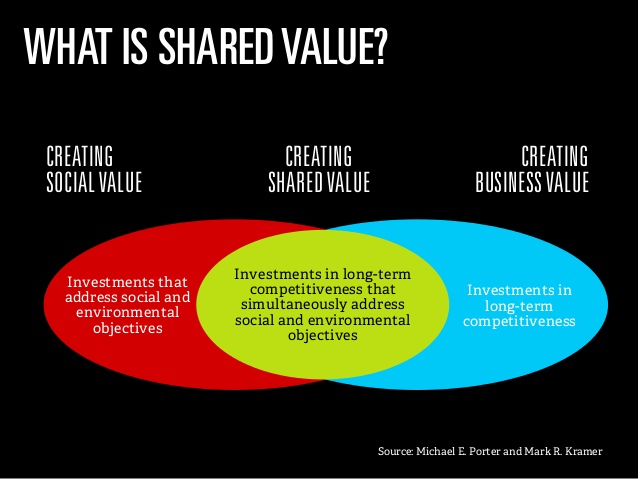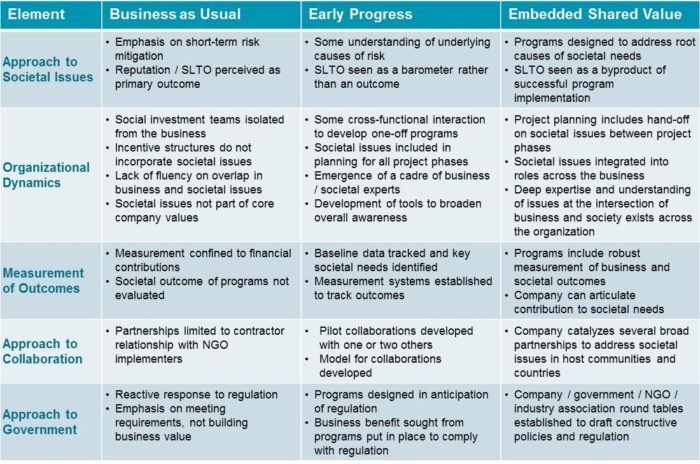Intro to Shared Value
Michael Porter, Harvard Business School Professor, and Mark Kramer wrote an article in 1999 called “Philanthropy’s New Agenda: Creating value, which discussed the idea that foundations could truly increase their social impact and adopt strategies aimed at creating value, instead of just pouring grant dollars. They then elaborated the Foundation Strategy Group in Boston in 2000. They expanded their concepts and expertise to nonprofits, governments, and corporations everywhere in the world before opening their office in Geneva, Switzerland. In 2011 they published a document called “Creating Shared Value” with its central point being ways for a business to make a profit and simultaneously solve social problems. They worked with partners such as the Clinton Global Initiative and the Rockefeller Foundation to create the Shared Value Initiative in 2012. In 2013 they created the Collective Impact Forum with the Aspen Institute Forum for Community Solutions, as well as with Grantmakers for Effective Organizations and others. In 2015, they partnered with groups to tackle inclusive markets in India for the development of housing, sanitation, and early childhood education. This year they started the Impact Hiring Initiative aimed at improving hiring, retention and advanced of the youth in populations whose young people struggle to find jobs.
An article by Chile Hidalgo, Associate Director at FSG discusses the uptake of the shared value concept by mining companies and tries to show how it differs from Corporate Social Responsibility (CSR) in that it tries to tackle the root of the problem of societal ills while ensuring that companies still make profits. In the following chart, he explains how companies may change their approach once they assimilate the shared value concept, at all levels:
To make this more understandable, because Shared Value and CSR do quite appear to be the same, he decides to compare what a typical business sustainability report might state, versus how it would be approached in terms of shared value:
Directly from the article: https://sharedvalue.org/groups/are-shared-value-and-corporate-social-responsibility-different-sustainability-report-re
Sustainability report: “We spent over $300 million sourcing goods locally, bringing the total amount spent with local companies over the last five years to more than $1 billion.”
Shared Value: “By developing and integrating local suppliers into our supply chain, we have created savings for the company of $100 million over the last 5 years based on lowered costs, improved responsiveness, and reduced delays and supply chain interruptions. In addition, local suppliers now provide employment to over 1,000 members of our host community.”
Sustainability report highlight: “We donated $2 million to help fund the construction of a local clinic.”
What a shared value approach might lead to: “Working in partnership with a global NGO, we reduced malaria rates in our local community by 90%, while at the same time reducing man-hours lost to the disease from 90,000 at the inception of the program to 700 this year.”
Sustainability report highlight: “We reduced our greenhouse gas emissions by nearly a million tons using enhanced treatment techniques.”
What a shared value approach might lead to: “We are investing in reducing our greenhouse gas emissions through enhanced treatment techniques because we believe CO2 will be taxed in the future and want to gain a competitive advantage by reducing the impact of future regulation on our business.”
Sustainability report highlight: “We donated over $1 million in response to disaster relief efforts following flooding in the south of the country.”
What a shared value approach might lead to: “Investing in disaster and emergency preparedness, response capabilities, and rehabilitation activities creates stronger, more resilient communities and helps ensure business continuity in the event of a major incident. In addition to making donations in response to disasters, we restored shorelines around our facilities and pipelines to better protect our assets and the local communities from climate-related events.”
Sustainability report highlight: “We committed $1 million to school districts to support literacy and career development programs.”
What a shared value approach might lead to: “We believe that it is a business imperative to invest in developing a local workforce. Hiring expatriates to work in this country costs ten times more than hiring locals. Developing the local workforce not only helps the business, it also gives members of our host communities access to higher-paying jobs and greater opportunities for economic development.”

One could argue then that Shared Value goes more in-depth than CSR. For a long time, CSR has been criticized as superficial. An industrial might build a hospital in a rural area, and distribute bags of rice, but what is the sustainability of it? The hospital might not be well maintained and only a few people in the community may have access; the locals could get used to the bags of rice, but once the mine is gone, what happens? However, if you take another industrial mine that comes with a shared value approach, they may work with locals to advocate for patches of land, or rent it to them; a group of women, for example, would start growing foodstuff, that becomes the sole source of ingredients used for the cooking of meals for mine workers, overtime lifting these women out of poverty. However, one could also argue that it, in the end, it is still about profit-maximizing and can mining ever be entirely sustainable? Are the roots of the social issues really being targeted here? What do you think?
